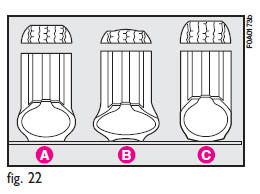Check the pressure of each tyre, including the spare, every two weeks and before long journeys.
The pressure must be checked when the tyre is rested and cold.
It is normal for the pressure to rise when you are driving. If you have to check or restore the pressure when the tyres are warm, remember that the pressure value must be 0.3 bar above the specified value.
See “Wheels” in “Technical specifications” for the correct tyre inflation pressure.
![]() Tyre pressure must be correct to ensure good road holding.
Tyre pressure must be correct to ensure good road holding.
Incorrect pressure causes abnormal tyre wear fig. 22:
A - Correct pressure: tyre wears evenly
B - Under inflated tyre: shoulder tread wear
C - Over inflated tyre: centre tread wear.

![]() If the pressure is too low the tyre overheats and this can cause it serious
damage.
If the pressure is too low the tyre overheats and this can cause it serious
damage.
Tyres must be replaced when the tread wears down to 1.6 mm. In any case, comply with the laws in the country where the vehicle is being driven.
See also:
Materials Added To Fuel
All gasoline sold in the United States is required to contain effective detergent
additives. Use of additional detergents or other additives is not needed under normal
conditions and would result ...
Inefficient abs system
Turning the ignition key to MAR the warning light on the dial turns on, but it
should go off after few seconds.
The warning light turns on (on certain versions together with the message on
th ...
Manually deactivating passenger’s front air bag (where required)
Should it be absolutely necessary to carry a child on the front seat, the passenger’s
air bag on the car can be deactivated.
Deactivation/reactivation takes place with ignition key at STOP and op ...


